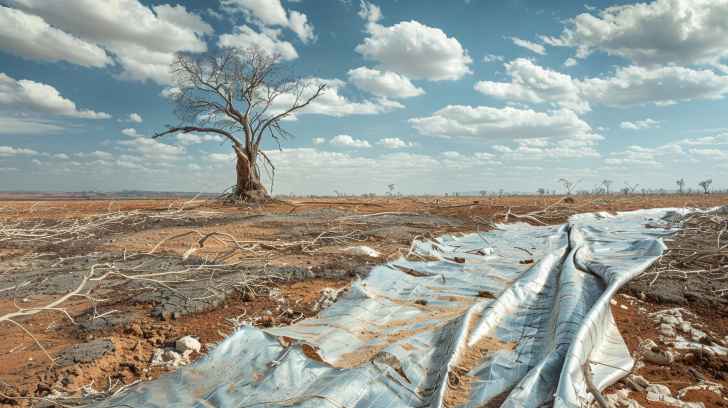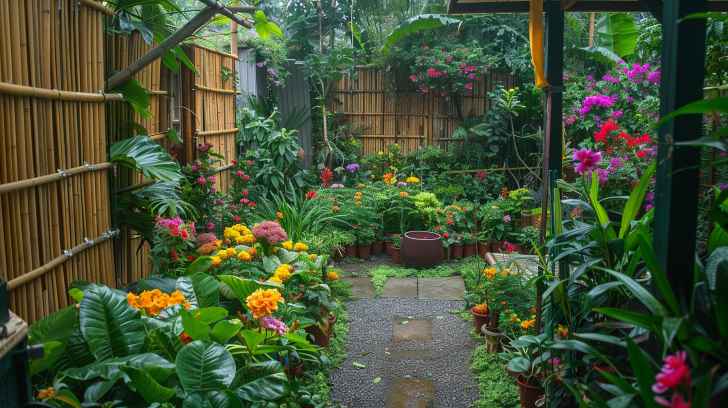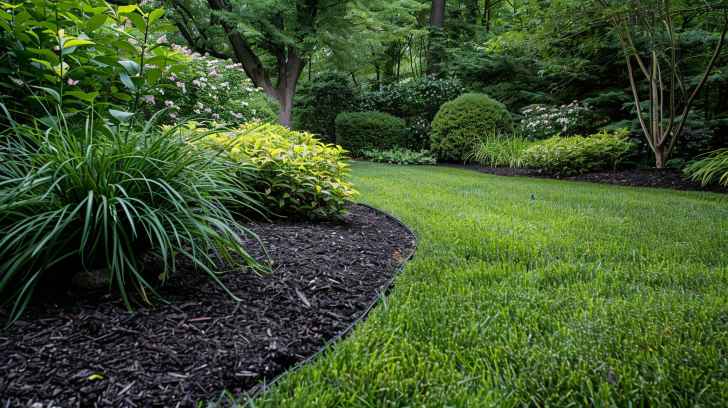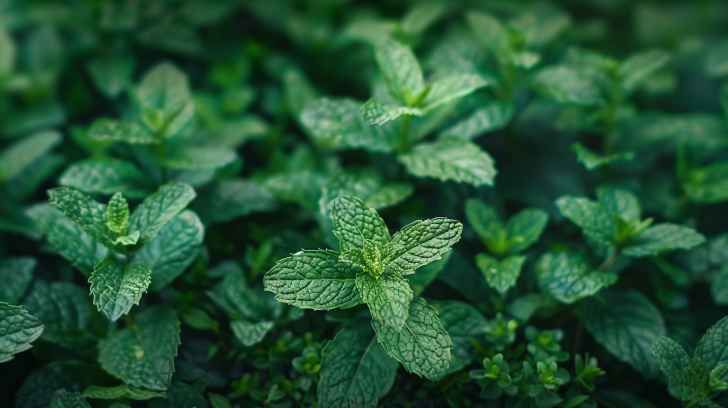Many HOAs and garden lovers use landscaping fabric to beat weeds. But now, some gardening experts think it does more harm than help. They believe it’s time to rethink this common method. Should we make it illegal to use?
Some say landscaping fabric brings more trouble than it’s worth. HOAs are upset as the fight between old and new gardening ways heats up. This debate makes us question if chasing a weed-free garden is leading us in the wrong direction.
Key Takeaways
- Landscaping fabric, long used for weed prevention, is now under scrutiny by gardening experts.
- Homeowners’ Associations (HOAs) face pressure to reevaluate the legality and environmental impact of landscape practices.
- New expert advice suggests that some conventional garden practices might be considered legal mistakes.
- Legal considerations and environmental impact are becoming increasingly important in landscaping trends.
- The conversation around sustainable landscaping practices is becoming more prominent as alternatives to landscaping fabric are explored.
The Dangers and Ineffectiveness of Landscaping Fabric as a Weed Control Method
Landscaping fabric is often weed control. But, many criticize its effectiveness and environmental impact. The fabric aims to stop weeds. But it often doesn’t work well and can hurt the environment.
Some experts say landscaping fabric can be a quick fix for ineffective weed control. However, it can break down. When it does, weeds can grow through it. This means more work and less value.
There’s also a worry about soil health under the fabric. The fabric can stop water and nutrients from getting to the soil. This can harm the soil and plants.
- Reduction of air and water permeability
- Disruption of natural soil organism activities
- Limited organic material reach
Because of these problems, more people support alternative landscaping methods. These methods can make gardens look good without hurting nature. They include mulching, using ground cover plants, and placing hardscapes wisely. These approaches help control weeds, improve soil, and support the ecosystem.
| Feature | Landscaping Fabric | Alternative Methods |
|---|---|---|
| Impact on Soil Health | Negative | Positive |
| Cost over 5 Years | Higher due to replacement | Lower with sustainable solutions |
| Environmental Impact | Contributes to microplastic pollution | Environmentally friendly |
| Weed Control Effectiveness | Initially high, decreases over time | Steady and sustainable |
The table shows why more gardeners and environmentalists prefer alternative landscaping methods. It’s about more than making gardens look good. It’s also about creating healthy ecosystems and choosing practices that protect our planet.
Environmental Impact: Soil Pollution and Wildlife Harm from Landscaping Fabric
Landscaping fabric, often made from plastics, harms the environment by breaking down slowly. It’s used in gardens and landscapes to stop weeds, but it actually causes big problems. These include soil pollution, harm to waterways, and hurting how the ecosystem works.
The Breakdown of Plastics and Consequences for Soil Health
As this fabric breaks down, it turns into microplastics that mix with the soil. This hurts the soil by messing with tiny organisms that help plants grow. In time, the soil can’t support plants well, which is bad for animals living there.

How Landscaping Fabric Contributes to Waterway Contamination
Bits of this fabric also end up in streams and rivers. When it rains, the microplastics get washed into the water. This is dangerous for people and water animals. It makes the water dirty and puts many species at risk.
Unintended Effects on Beneficial Microorganisms and Nutrient Cycling
Landscaping fabrics block the soil’s natural processes. This upsets the good microbes in the dirt that are key for plants’ food. This leads to less healthy soil and fewer types of plants and animals in those places.
| Aspect of Environmental Impact | Consequences |
|---|---|
| Soil Health Deterioration | Decrease in fertility and structural integrity due to microplastic buildup |
| Wildlife Harm | Ecosystem disruption leading to loss of habitat and biodiversity |
| Waterway Contamination | Introduction of toxic substances and microplastics into aquatic environments |
Understanding these issues shows the real cost of using non-biodegradable landscaping fabric. It points out why it’s important to choose sustainable ways to garden. These methods keep the soil and water safe and help protect our ecosystem’s balance.
Alternatives to Landscaping Fabric: Promoting Sustainable Landscaping Practices
The push for sustainable landscaping is growing. Finding green alternatives to landscaping fabric is key. It helps our gardens thrive without harming the planet. Mulching is one great option. It fights weeds and keeps soil moist without bad plastics.
Ground cover plants are another great choice. They make the soil look good and stop weeds. Creeping thyme and sedum can transform a garden into a lush area. Manual weeding takes more work, but it gets rid of weeds safely. It protects other plants and the soil’s health.
Organic gardening fits well with these options. It uses biodegradable materials and permeable barriers. This approach boosts the soil’s condition. It allows air and water to move freely. Using organic mulches like straw or cocoa bean shells is smart. Natural edging also helps in defining garden spaces.

| Method | Benefits | Considerations |
|---|---|---|
| Mulching | Moisture retention, weed suppression | Needs regular replenishment |
| Ground Cover Plants | Beautifies garden, controls erosion | Select species based on climate |
| Manual Weeding | Targeted weed control, no chemicals | Labor-intensive |
| Biodegradable Barriers | Eco-friendly, boosts soil health | May decompose rapidly in wet conditions |
By using these sustainable practices, gardeners lessen their environmental impact. They keep their gardens lovely and alive. Choices like mulch use and careful plant selection make a big difference. Every bit helps our planet stay healthy.
Conclusion: Reconsidering Landscaping Fabric Use in Light of Expert Advice and Legal Considerations
Our journey into gardening teaches us a vital lesson: the value of green methods. While many have used landscaping fabric to stop weeds, experts now guide us towards greener paths. These experts, both landscapers and environmentalists, tell us about the harm synthetic materials can do. They push for better choices that help plants grow and keep the earth safe.
Thanks to this advice, gardeners and Homeowners’ Associations are picking mulches, plant covers, and hand weeding. These choices cut down the need for landscaping fabric. They work well and respect laws designed to guard our environment. By following these tips, we do our part in protecting nature. This shift is as much about doing what’s legal as it is about doing what’s right.
So, we must look closely at how we use landscaping fabric, thinking of our planet’s health. Gardeners and HOAs need to examine their methods, aiming to impact the earth lightly. Choosing sustainable ways, approved by experts and the law, helps us make a positive change. Together, we can build a healthier, more beautiful world for the future.
FAQ
Why do experts believe some landscaping practices should be considered illegal?
Some landscaping practices are bad for the environment. For example, non-biodegradable landscaping fabric used for stopping weeds harms soil health. It kills important microorganisms and adds to plastic pollution. This problem has led to discussions among homeowners and calls for legal actions for better landscaping methods.
What are the dangers of using landscaping fabric for weed control?
Landscaping fabric doesn’t always stop weeds for good. It can choke the soil, block nutrients and water, and harm the earth. Over time, this fabric breaks into tiny plastic pieces, which pollute the soil and waters. It’s an environmental risk that also hurts wildlife.
How does the breakdown of plastics from landscaping fabric affect soil health?
When landscaping plastics break down, they change soil structure and chemistry. This hurts the tiny organisms that help plants get nutrients. Poor soil health leads to weak plants and harms the environment over time.
Can landscaping fabric contribute to waterway contamination?
Yes, when landscaping fabric falls apart, plastic bits can end up in rivers and lakes. This pollution harms people’s health and threatens fish and other aquatic life. It introduces dangerous pollutants to water habitats.
What impact does landscaping fabric have on beneficial microorganisms in the soil?
Landscaping fabric limits the soil’s oxygen and moisture. These are needed by helpful microorganisms. Without them, these tiny life forms can’t do their job. This hurts plant growth and makes the soil less fertile.
What are alternative landscaping methods that may be more effective and sustainable than using fabric?
Instead of using fabric, there are greener options. Use organic mulch, plant ground cover, pull weeds by hand, or follow organic gardening tips. These ways are better for the earth. They keep the soil healthy, fitting with new, eco-friendly landscaping trends.
How should gardeners and HOAs approach weed prevention in light of expert advice and legal considerations?
Gardeners and homeowners’ groups should look to experts for advice on green landscaping. Consider the laws and eco guidelines to make sure your garden choices do no harm. Knowing gardening tips and following eco trends can help pick the best, earth-friendly options.






